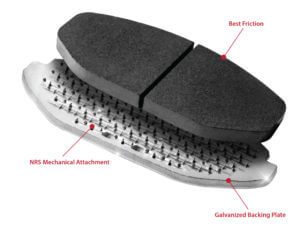OEM brake pad backing plate information now available
OEM brake pad backing plate information now available to brake pad manufacturers
Many car and truck manufacturers install brake pads that are mechanically attached to the backing plate. See this post on the Nucap NRS backing plate to see how that method works. Unfortunately, many brake pad manufacturers continue to bond the friction material to the backing plate using an adhesive method that doesn’t match the OEM pads. Adhesive methods simply aren’t as good as the OEM mechanical attachment methods and studies show they fail early (see this post).
FSMI now lists OEM brake pads that use mechanical attachment methods
The Global Brake Safety Council (GBSC) recently issued a press release heralding the Friction Materials Standards Institute (FSMI) catalogue of these OEM mechanically attached brake pads a “remarkable improvement in the advancement of brake pad safety for consumers.”
The FSMI update acknowledges the fact that certain vehicle applications were specified – by OE manufacturers – to have mechanical attachment between the steel backing place and the friction material. The improved attachment method is critical due to the specific application design for high-load applications where adhesive alone has been proven to lead to pad failure.
According to GBSC, “it is critical that this very vital information is finally being shared with the North American aftermarket brake pad manufacturers and suppliers that comply with the FMSI numbering system.
The council says the integrity of mechanical attachments for brake pads should be treated very seriously. “Removing the mechanical attachment feature will greatly compromise the structural integrity of the entire brake system, putting consumers in danger of brake failure,” a council bulletin states.
“This recognition by FMSI and industry wide awareness will help improve safety and quality of aftermarket brake pads across North America—a critical step forward for a vehicle’s most paramount safety item, its brakes.”
GBSC describes the mechanical attachment for brake pads as similar to rebars set in concrete
“Just like rebar-reinforced concrete, you cannot see the attachment

Nucap NRS backing plates mechanically bond the friction material to the backing plate with hooks
in a brake pad, but it is designed into the system by engineers and must not be removed by aftermarket pad manufacturers,” the safety council release states. “Removing the mechanical attachment feature will greatly compromise the structural integrity of the entire brake system.”
The 42 D-numbers identified by the FMSI represent approximately 100 Million cars, trucks and school buses on the road in North America, and the aftermarket – or replacement – brake pads for these vehicles should be manufactured with the OE specified mechanical attachment feature in order not to jeopardize safety.
If you purchase brake pads for a vehicle that was engineered with mechanically attached brake pad backing plates and the new pads use an adhesive bonding method, you won’t get the same performance or useful life from the pads. INSIST on OEM design mechanically attached backing plates.
Posted on by Rick Muscoplat